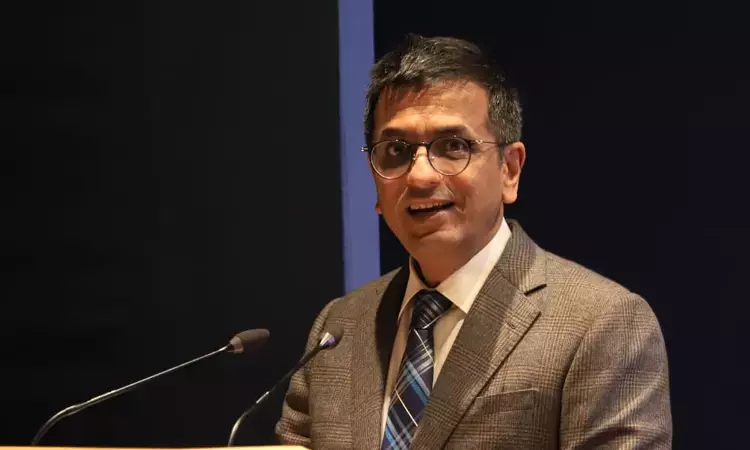- Home
- /
- Top Stories
- /
- Supreme Court's Expansion Building...
Supreme Court's Expansion Building Not Only Expands Physical Space But Also Capacity To Deliver Justice : CJI DY Chandrachud
Anmol Kaur Bawa & Gursimran Bakshi
14 Oct 2024 7:38 PM IST
Chief Justice of India DY Chandrachud today (October 14) expressed that the project for expanding the Supreme Court Complex was not just intended to expand the physical capacity of the Apex Court but also the 'capacity for justice'.While speaking at the inaugural address for the Groundbreaking Ceremony for the Expansion Building of the Supreme Court, the CJI emphasised that the expansion of...
Chief Justice of India DY Chandrachud today (October 14) expressed that the project for expanding the Supreme Court Complex was not just intended to expand the physical capacity of the Apex Court but also the 'capacity for justice'.
While speaking at the inaugural address for the Groundbreaking Ceremony for the Expansion Building of the Supreme Court, the CJI emphasised that the expansion of the complex was done with the intention to take under its fold increased accessibility, caseloads and judicial efficiency.
"The expansion is designed to accommodate the increasing caseloads, new judicial benches and requirements of our judges, lawyers and citizens. The expansion is not just about increasing physical space. It is about building capacity for justice. We are not just adding space, we are expanding our capability to deliver justice in a timely and dignified manner," the CJI added.
He further explained how the Original Supreme Court building was inspired by the scales of justice with the central wing symbolizing the beam, the two wings representing balance, and semi-circle hooks at the end representing pans of the scale.
The expansion of the building reflects the progress of the Country's social and legal desires and the need to maintain the Rule of Law.
"The vision behind this architectural marvel has stood the test of time. The evolution of this structure mirrors the evolution of our society from post-independent nation to global leader, upholding the rule of law."
A PwD-Oriented & Eco-Friendly Supreme Court
The CJI emphasized that the expansion building will be fully accessible, incorporating the features of friendly persons with physical disabilities. It will have automatic doors, ramps, lifts, adequate signage for navigation and clearly defined rules for emergency evacuation.
He added that the complex will have furniture and interior accommodative of the needs of PwDs
"Persons with disabilities will find adjustable furniture, designated sitting areas in courtroom, and public spaces, and accessible restrooms and parking spaces."
The expansion project, the CJI mentioned was also 'environmentally conscious'.
On The Phased Development Of The New Complex
The CJI explained the site plan and facilities that the new complex will entail. While the original building will remain intact, the subsequent additions will make way for new state-of-the-art facilities.
He said: "Phase I, which is being initiated today, will be completed within 29 months. It will cover approximately 38,250 square meters and consist of two basements and a five-story building. The ground floor will be dedicated to lawyers' utility spaces, including a library, canteen, and offices for the Supreme Court Bar Association and the Supreme Court Advocates-on-Record Association. The upper floors will accommodate courtrooms, judges' lounges, court offices, and the Chief Justice's chambers."
The new structure spread over 86,500 sq mts of built-up area will be constructed in 2 phases.
CJI added: "By the time we complete Phase II, which will span an additional 48,250 square meters over three- and four-story blocks, the Supreme Court will have gained an additional 29 courtrooms, 43 new judges' chambers, and dedicated spaces for registrars and lawyers. Notably, the Constitutional Court, with its 17-judge bench, will be placed on the fifth floor of the new structure."
With this expansion, we are not just adding rooms or court spaces—we are creating an environment that upholds the dignity of the people who visit the court and manifests the hallowed grounds that have upheld and advanced the intricately woven threads of justice in the tapestry of our constitutional spirit, CJI averred.
The event was also attended by Minister of Housing and Urban Affairs, ML Khattar; Minister of Law & Justice, Arjun Ram Meghwal; Sitting Judges of the Supreme Court as well as AG R. Venkataramani; SG Tushar Mehta, BCI Chairman Manan Kumar; SCBA President Kapil Sibal, SC AoR Association President Vipin Nair and former judges of the Supreme Court.
Chief Justice of India D.Y. Chandrachud will address during the Groundbreaking Ceremony for the Expansion Building of the Supreme Court scheduled today.#supremecourt #expansionbuilding pic.twitter.com/YfkZdn060r
— Live Law (@LiveLawIndia) October 14, 2024


